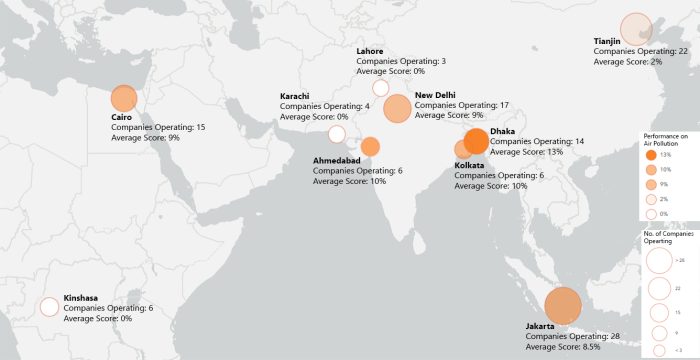Key finding
Companies are taking minimal action to address deadly pollutants that threaten urban public health
Urban companies are doing alarmingly little to address toxic pollutants endangering public health
Authors: Vibhuti Patel and Rohan Luthra
Of all the environmental threats to urban public health, noise and air pollution are among the most dangerous (WHO, 2011). Air pollutants such as particulate matter (PM) contribute to and exacerbate respiratory and cardiovascular conditions (Hänninen, et al., 2014)). PM, for example, is linked to asthma, lung cancer and premature mortality. The World Health Organisation (WHO) estimates that 99% of the global population breathes air that exceeds safe pollution levels, particularly in urban areas of low- to middle-income countries (LMICs) like Bangladesh, Chad, Democratic Republic of the Congo, India and Pakistan, where fewer than 1% of cities meet recommended healthy thresholds (WEF, 2025).
Noise pollution is similarly harmful to urban residents, having been linked to cardiovascular disease (Münzel, et al., 2018), stroke, sleep disturbance, cognitive impairment (Harvard T.H. Chan School of Public Health, 2023), depression and anxiety (Kuntic, Al-KindI, & Hahad, 2025). Between 20-50% of urban populations are exposed to harmful levels of noise pollution, with long-term exposure estimated to contribute to 48,000 new cases of ischemic heart disease and 12,000 premature deaths every year in Europe alone (EEA, 2022) .
Industrial activities are a major source of poor urban air quality and harmful PM levels, with construction, real estate, transport and waste management being the top contributing sectors (Clean Air Fund, 2025). Similarly, urban transport and construction are the primary sources of noise pollution. The underwhelming performance of the biggest companies in these sectors in the 2024 Urban Benchmark is therefore deeply concerning. These companies operate in 43 megacities, home to over 692 million people, as well as hundreds of other cities, affecting the health of a significant number of people. However, only 1.5-3% of the benchmarked companies reported reductions in key air pollutants such as PM, nitrogen oxides (NOx) and sulphur oxides (SOx). In the transport and construction sectors, just 13% of the companies reported actions to mitigate noise or vibration levels.
Opaque reporting, opaque ambition and opaque skies
A striking 83% of the world’s 300 largest urban companies failed to regularly report air pollution data (for at least three consecutive reporting cycles) in their key sustainability reports. More concerningly, 96% of them did not disclose targets to reduce their air pollution impacts. Industry performance is mixed. The energy sector stands out, with 42% of companies — significantly above the average — reporting regularly.
Private sector inaction is contributing to air-pollution-related deaths and billions in healthcare costs yearly
Only nine companies reported consistent reductions in air pollutants (year-on-year for at least three consecutive reporting cycles). Further, only three companies — Acciona, Greentown China Holdings and Larsen & Toubro — disclosed consistent reductions in either PM2.5 or PM10, a concerningly low number given the significant threat these pollutants pose to public health.
Noise pollution, the “invisible killer” companies are ignoring
In addition to air pollution, 77 companies from the construction and transport sectors were assessed on their strategies, monitoring and measures to reduce noise and/or vibration from their activities. Again, the results reveal significant concerns. Only ten companies (13%) currently implement measures to reduce noise and/or vibration impacts.
To safeguard public health, companies need clear targets and accountability
Companies need to set time-bound targets and evaluate progress to mitigate their impacts on urban public health. Clear goals paired with regular monitoring demonstrate concrete commitment and accountability and encourage continuous improvement. These measures were used by Taiwan Power, an energy company serving over 15 million users across Taiwan and the best performer on the 2024 Urban Benchmark air pollution indicator.
Bibliography
Clean Air Fund. (2025). Investment case study for air pollution reduction in Amritsar and Gurugram, India. Clean Air Fund.
EEA. (2022, European Environment Agency). European Environment Agency. Retrieved from Health risks caused by environmental pollution: https://www.eea.europa.eu/publications/health-risks-caused-by-environmental
